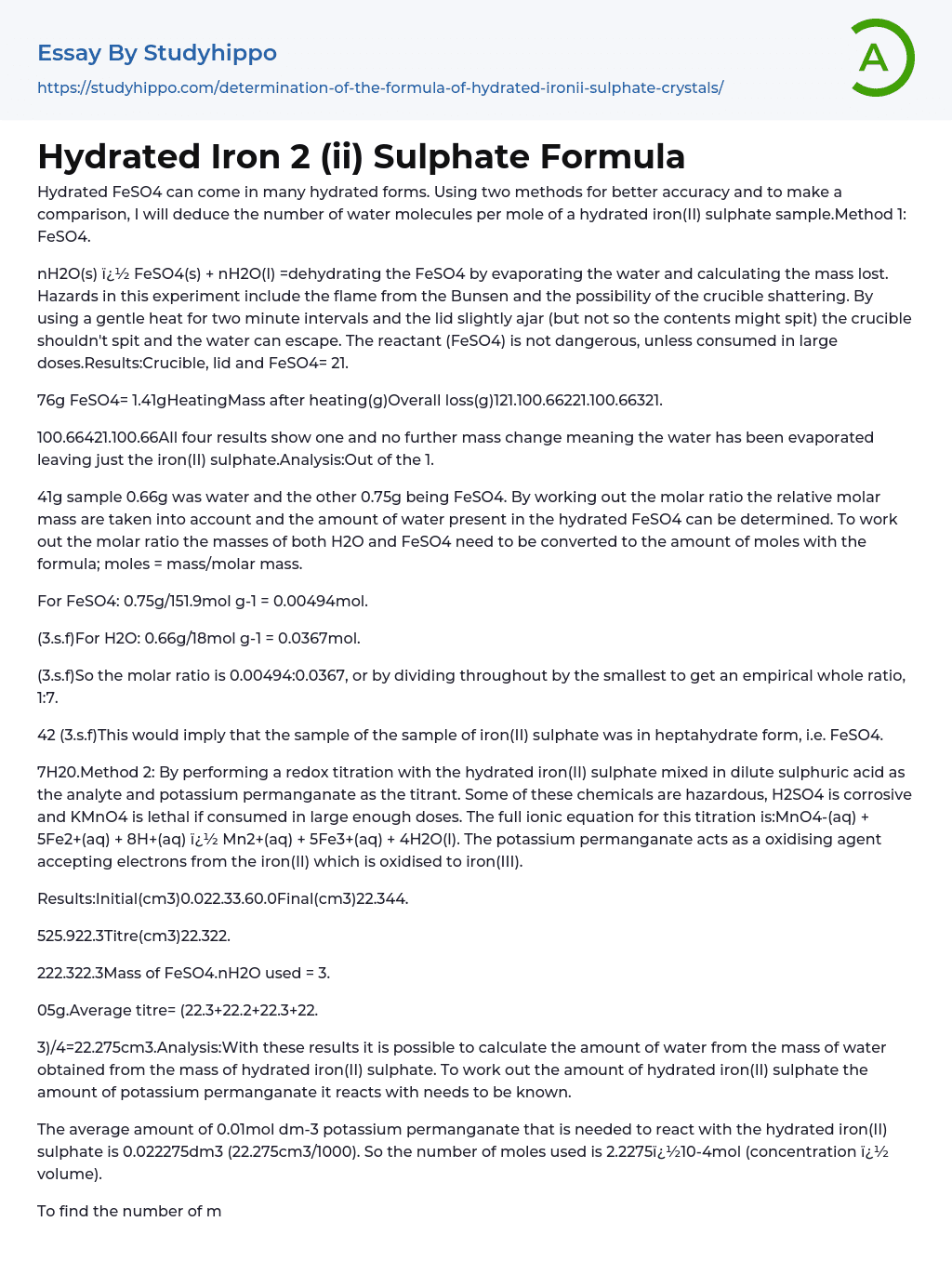
Hydrated FeSO4 can come in many hydrated forms. Using two methods for better accuracy and to make a comparison, I will deduce the number of water molecules per mole of a hydrated iron sulphate sample.
Method 1:
FeSO4. nH2O(s) ½ FeSO4(s) + nH2O(l) =dehydrating the FeSO4 by evaporating the water and calculating the mass lost. Hazards in this experiment include the flame from the Bunsen and the possibility of the crucible shattering. By using a gentle heat for two minute intervals and the lid slightly ajar the crucible shouldn't spit and the water can escape. The reactant is not dangerous, unless consumed in large doses.
Results
Crucible, lid and FeSO4= 21.
76g FeSO4= 1.41g
Heating
Mass after heating(g)
121.100.66221.100.66321.
Overall loss(g)
100.66421.100.66
All four results show one and no further mass change meaning the water has been evaporated leaving just the iron s
...ulphate.
Analysis: Out of the 1.
41g sample 0.66g was water and the other 0.75g being FeSO4. By working out the molar ratio the relative molar mass are taken into account and the amount of water present in the hydrated FeSO4 can be determined. To work out the molar ratio the masses of both H2O and FeSO4 need to be converted to the amount of moles with the formula; moles = mass/molar mass.
- For FeSO4: 0.75g/151.9mol g-1 = 0.00494mol.
- (3.s.f)For H2O: 0.66g/18mol g-1 = 0.0367mol.
- (3.s.f)So the molar ratio is 0.00494:0.0367, or by dividing throughout by the smallest to get an empirical whole ratio, 1:7.
- 42 (3.s.f)This would imply that the sample of the sample of iron(II) sulphate was in heptahydrate form, i.e. FeSO4. 7H20.
Method 2:
By performing a redox titration with the hydrated iron(II) sulphate mixed in dilute sulphuric acid as the analyte and
potassium permanganate as the titrant. Some of these chemicals are hazardous, H2SO4 is corrosive and KMnO4 is lethal if consumed in large enough doses. The full ionic equation for this titration is: MnO4-(aq) + 5Fe2+(aq) + 8H+(aq) ½ Mn2+(aq) + 5Fe3+(aq) + 4H2O(l). The potassium permanganate acts as a oxidising agent accepting electrons from the iron(II) which is oxidised to iron(III).
Results:
- Initial(cm3)0.022.33.60.0Final(cm3)22.344.
- 525.922.3Titre(cm3)22.322.
- 222.322.3Mass of FeSO4.nH2O used = 3.
- 05g.Average titre= (22.3+22.2+22.3+22.3)/4=22.275cm3.
Analysis:
With these results it is possible to calculate the amount of water from the mass of water obtained from the mass of hydrated iron(II) sulphate. To work out the amount of hydrated iron(II) sulphate the amount of potassium permanganate it reacts with needs to be known.
However, the anomaly is only off by 0.1cm3 and this would have a huge impact. Therefore the inaccurate answer must come from another factor. I think that the scales measuring only to the nearest hundredth of a gram produced only rough figures for the small scale titration that was carried out.
Scales with a greater resolution, or more realistically the experiment being carried out on a larger scale would reduce this error margin although this is only practical in laboratories and not schools. The good thing about method one is that there are less of these sums that can amplify errors and even though the same weighing scales were used the lack of sums with many decimal places reduces the error margin. This method generally relies on chemistry instead of maths and the only variable that could have caused the off answer was again the scales. Carrying out this experiment on a larger scale would be far too dangerous in
a school due to the use of fire.
The problem with method one being more in touch with chemistry is the risk of procedural errors. On heating the melanterite the substance changed in colour from blue to white indicating the water had been eliminated. However, there were also areas of dark red which indicate a further reaction. The heat was too strong and iron(III) oxide was formed with sulphur di- and trioxide: 2FeSO4(s)½ Fe2O3(s) + SO2(g) + SO3(g). These gases also escaped with the water and gave the impression that there was more water present as some sulphur and oxygen escaped as well. Heating the melanterite more gently and patiently for less time would make sure this didn't happen. If this didn't happen I am confident that this method would be more accurate than a titration as it is more purely chemistry instead of maths, which holds a greater chance of carrying errors over, despite my results suggesting otherwise.
- Accounting essays
- Marketing essays
- Automation essays
- Business Cycle essays
- Business Model essays
- Business Operations essays
- Business Software essays
- Corporate Social Responsibility essays
- Infrastructure essays
- Logistics essays
- Manufacturing essays
- Multinational Corporation essays
- Richard Branson essays
- Small Business essays
- Cooperative essays
- Family Business essays
- Human Resource Management essays
- Sales essays
- Market essays
- Online Shopping essays
- Selling essays
- Strategy essays
- Management essays
- Franchising essays
- Quality Assurance essays
- Business Intelligence essays
- Corporation essays
- Stock essays
- Shopping Mall essays
- Harvard Business School essays
- Harvard university essays
- Trade Union essays
- Cooperation essays
- News Media essays
- Waste essays
- Andrew Carnegie essays
- Inventory essays
- Customer Relationship Management essays
- Structure essays
- Starting a Business essays
- Accounts Receivable essays
- Auditor's Report essays
- Balance Sheet essays
- Costs essays
- Financial Audit essays
- International Financial Reporting Standards essays
- Tax essays
- Accountability essays
- Cash essays
- Principal essays



